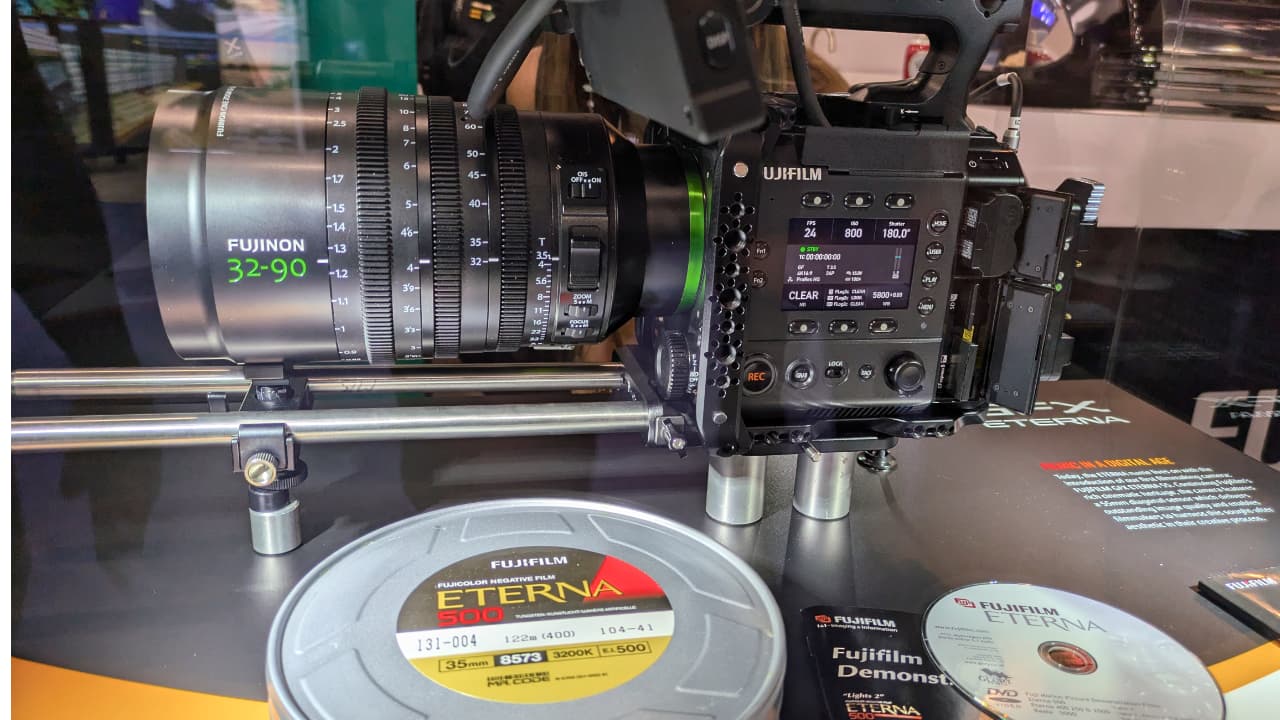
Gaining a lot of attention on the NAB show floor, even under glass, Fujifilm also unveiled some new features coming to its eagerly awaited GFX ETERNA when it launches later this year.
The pursuit of better cameras has been a noble crusade of the film industry for so long that it’s easy to forget what it was all about until we encounter Fujifilm’s GFX ETERNA, switched on and with pictures on screen. The ETERNA is, according to the company, its first ever cinema camera, announced at the end of 2024 - and part of a fairly recent phenomenon in which companies specialising in stills cameras take that technology and build a dedicated moving-picture device around it.
Let’s be clear that Fujifilm is cautious about describing the ETERNA as based on the GFX-100, exactly. It shares the GFX 100 II’s sensor and the first stage of image processing, and not much else. This is still important, because that implies the new camera is doing a lot of the heavy lifting in the piece of custom silicon developed for the extant stills device. Many cinema cameras at this level of capability do absolutely all their processing in programmable logic, which is (vastly) cheaper to develop but consumes more power and munches through more batteries while getting hotter, requiring more cooling and therefore making more noise. Application-specific integrated circuits do better in all those regards, so the ETERNA ought to have long legs, at least in comparison to its vast potential capability.
Lensing ETERNA
Considering that the company has long made a huge range of lenses and a range of very respectable mirrorless cameras, the lack of any option to connect them together has sometimes seemed like an oversight that sent people Googling for adaptor options.
The issue is addressed, at least in the context of the ETERNA, by an in-house mount for PL lenses. As we might expect, the mount which is native to the camera, being stills-derived, is not really designed to physically support the kinds of lenses which are capable of filling the ETERNA’s positively continental sensor. The problem is solved by bolt-down points around the sensor to create a sturdier structure. Even then, the sort of lenses which are likely to satisfy the ETERNA (particularly Fujifilm’s own awesome-but-chunky zooms) will also be those which still need external support.
There are some very creditable design niceties - an electronic ND if you want it, which physically slides out of the way if you’d prefer to provide your own, plus a small, onboard, mirrorless-sized battery to cover main battery changes. The ETERNA is, overall, a fairly compact device, packing what should be a titanic amount of capability into a fairly unassuming package. The lens will often be longer than the camera body on ETERNA setups.

Fujifilm's Michael Bulbenko (left) with the GFX ETERNA, shown strictly under glass
Max ETERNA?
The thing is, the GFX ETERNA seems likely to be part of a mid-2020s camera scene in which lots of cameras are titanically capable. Blackmagic’s 80-megapixel, 12K sensor seems destined to be the normal option in its range, to say nothing of its even more capable and upscale options.
Philosophically, all this performance - beyond just being an embarrassment of riches - really does change camerawork somewhat, at least if we’ve good enough lenses. One of the reasons the high end routinely produces such good results is that its equipment has enough excess performance that mistakes are correctable. Noise is low enough to save underexposure. Resolution is high enough to shoot loose and stabilise later. Anyone shooting a sensor of this size and resolution probably isn’t doing it right unless they’re framing generously and Finchering the operating in Resolve. Either way, if any dedicated cinema camera deserved to remind people of really huge film formats, this has to be it. Its native sensor aspect ratio is closer to 15/65 (that is - IMAX) than anything else.
Whether the camera crusade will ever draw to a close is a crystal-ball issue. What’s certainly true - especially as we coast gently through the hundred-megapixel watershed for cinema cameras - is that the numbers game has been pointless for years, if it ever wasn’t. The resolution of modern cameras is so much more than adequate that we’re now really just characterising the diffraction limits of various focal lengths, a reality of optical physics which even the most careful lens manufacturer can’t do much about.
For now, it’s not quite clear whether the GFX ETERNA will carve a niche for itself with the high end, or whether it will become the ambitious film student’s tool of choice. The answer may well be “both.” No firm price has yet been released, but that might tilt the balance one way or the other.
Andy Stout adds, while there was no formal announcement, Fujifilm did unveil quite a few new features for the ETERNA at NAB.
- Variable Electronic ND Filter Specifications
- ND Density: ND0.6 – ND2.1
- Internal NP-W235 battery compatibility in addition to external power support
- NP-W235 enables hot swapping of external batteries or transition to DC input. Battery is automatically charged via external power source
- Internal Memory Card Support
- CF Express Type B and SD media
- Compatibility with TASCAM XLR microphone adapter handle accessory
- Support for expanded audio input compatibility
- Support for Adobe Frame.io Camera to Cloud
- Utilize built-in network interfaces (WiFi or Ethernet) for internet connection to authenticate to a Frame.io project and upload files securely to central location for immediate accessibility
Tags: Production Fujifilm NAB 2025


Comments